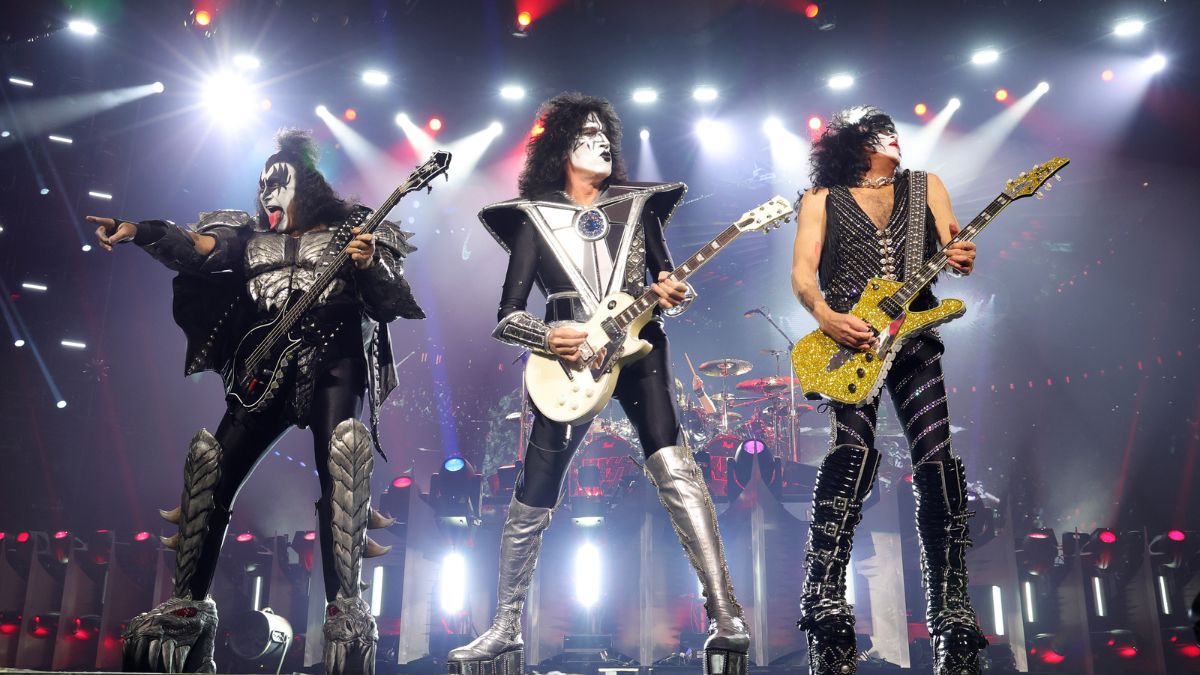The 50 greatest moments in electric guitar history
The guitar received its first jolt of electricity more than 130 years ago – and it’s been humming along ever since. Here are 50 milestones worth celebrating
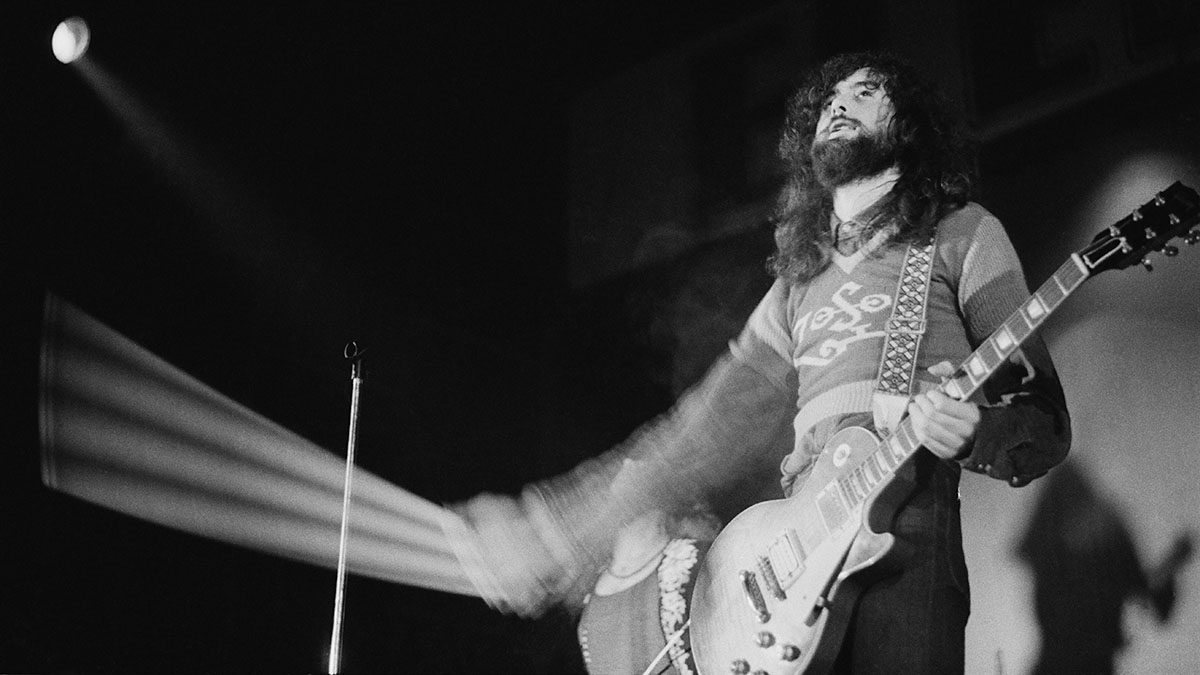
An acoustic guitar is a wonderful thing. It’s expressive, it makes a beautiful noise and it’s portable. You can take it anywhere and it will work just fine, from a New York City subway station to the top of Whiskey Dick Mountain in Washington. Its only drawback is it’s a little quiet. One-on-one, a piano, a trumpet or tuba will kick its mellow ass.
As early as 1890, guitarists knew they needed amplification if they were going to be heard. And they were right. Once the instrument found its way to a wall socket, the guitar became an unstoppable force powering the music of Elvis Presley, the Beatles, the Rolling Stones and… Cannibal Corpse!
Over the next 12 pages, Guitar World traces the electric guitar’s evolution – from shrinking violet to life of the party – in 50 astonishing moments. So, buckle up and hold on to your Strat. It’s gonna be a wild ride.
1. The nation’s first electricity-generating power station opens its doors (September 4, 1882)
What does the first power station have to do with the electric guitar? Well, ya can’t have an electric guitar without electricity, ya big dummy! In 1882 Thomas Edison helped form the Edison Illuminating Company of New York, which brought electric light to parts of Manhattan, but progress was, er, shockingly slow.
Most Americans still lit their homes with gas light and candles for another 50 years. Only in 1925 did half of all homes in the U.S. have electric power, and it wasn’t until 1960 that virtually all dwellings had electricity.
2. The first patent for an electric guitar design is given to inventor George Breed (September 2, 1890)
In September 1890, U.S. Navy officer George Breed was granted a patent for a design for an electrified guitar. His design was based on a vibrating string in an electromagnetic field, but his “guitar” was small and extremely heavy, and it produced only exceptionally bizarre sustained sounds reminiscent of a cat in heat.
Breed is now almost completely unknown as a musical-instrument maker and his instrument now resides in the dustbin of obscurity, but, hey, you gotta start somewhere…
All the latest guitar news, interviews, lessons, reviews, deals and more, direct to your inbox!
3. Lee de Forest patents the first electronic amplification device (January 29, 1907)
Let’s face it, an electric guitar without an amp sucks, and that’s where Lee de Forest comes in. De Forest’s father was a Congregational Church minister who hoped his son would also become a pastor; instead the young man invented the first electronic device for controlling current flow – the three-element “Audion” triode vacuum tube.
This jump-started the Electronic Age and enabled the development of the electronic amplifier, which years later was used by bands like Slayer. So much for being a pastor’s son. De Forest also boasted that he made, then lost, four fortunes. Sounds like our kind of guy!
4. The first paper-cone loudspeaker is developed by Chester Rice and Edward Kellogg (1921–1925)
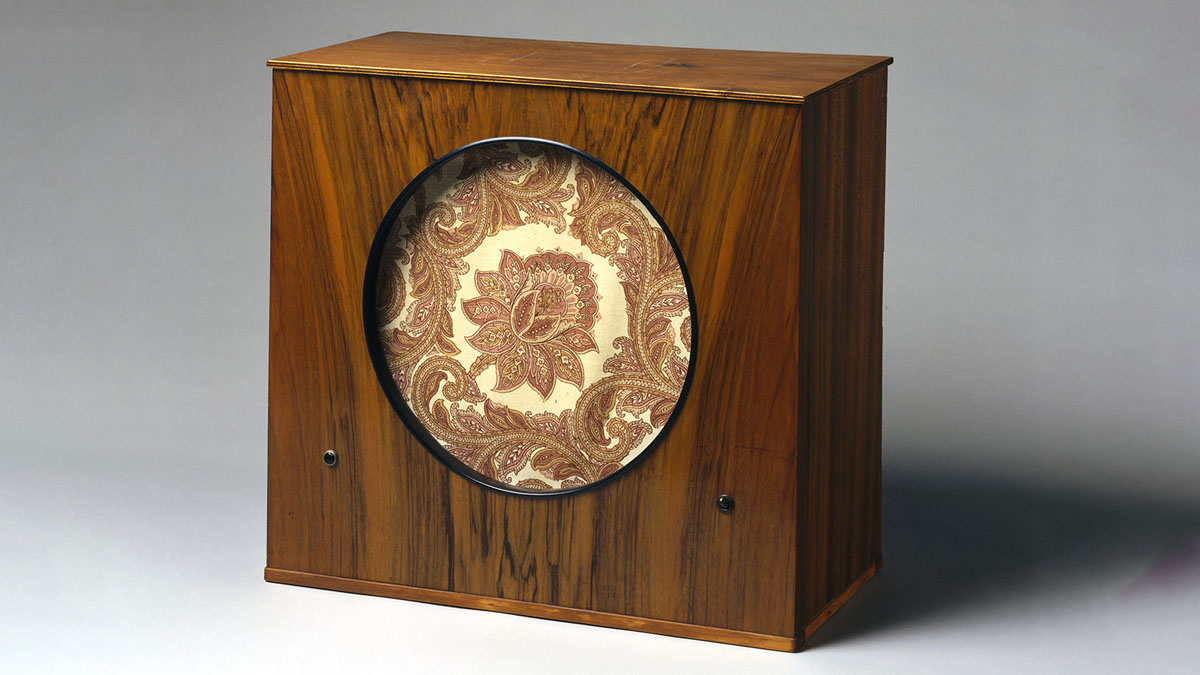
If you think an electric guitar without an amp sucks, how about an amp without speakers? Yeah, the electric guitar needed those, too. Luckily, Chester W. Rice and Edward W. Kellogg, a couple of clever dudes who worked at General Electric laboratories, put their heads together and came up with the modern loudspeaker, which combined the moving coil driver mechanism with a paper cone diaphragm.
They invented the concept in 1921, but it took until 1925 to improve the acoustics enough to compete with existing horn loudspeakers. The speaker’s advantage was that it had a flatter frequency response than horn speakers and could reproduce adequate bass without the enormous length of sound path required in horns.
5. The Stromberg-Voisinet Electro, the first commercial electric guitar, is introduced to general indifference (1928–1929)
The Stromberg-Voisinet Electro was, by all reports, a substantial leap forward from George Breed’s initial crude attempt at building an electric guitar. It employed an electromagnetic pickup device mounted beneath the top of a conventional hollow-body guitar, and it was capable of transforming vibrations from the instrument’s wooden top into an electrical signal that could be amplified. So far, so good – but what did the S-V Electro sound like?
It’s difficult to say, because no surviving examples are known to exist. Only a small number of these guitars were produced in 1928, and by mid 1929 they had completely vanished from the marketplace.
While some blame the Electro’s failure on the Great Depression, historians have long speculated that so few players bought them because they sounded terrible, and those who did eventually tossed them in the trash.
6. The production model of the Ro-Pat-In Electro A-25 “Frying Pan” hits the market (September 1932)

Now we’re cooking with fire! Hailed as the first successful commercially produced electric solid body guitar, the Ro-Pat-In Electro “Frying Pan” wasn’t much to look at, but it sounded fine and you could coax a respectable amount of volume out of it without incurring feedback.
Invented by guitarist George Beauchamp, the “frying pan” (nicknamed because its circular body and long neck made it resemble a frying pan), featured an aluminum body and a pickup that incorporated a pair of horseshoe magnets that arched over the strings.
While it was overshadowed by the flood of electric guitars that followed in its wake, true six-string aficionados will always regard the A-25 as the indisputable Big Bang.
7. The first public electric guitar performance (October 31, 1932)
If you play Master of Puppets in a forest, and there’s no one around to hear it, does it make a sound? Probably. But let’s face it, playing guitar is usually more satisfying when there’s an audience to appreciate it.
The very first sale of an A-25 Frying Pan was to Wichita, Kansas, guitarist Gage Brewer, who made the purchase on September 21, 1932. He also holds the distinction of having given the first-ever known public performance with it. A press release issued to promote the concert informs us it took place at the Shadowland Pavilion, a Wichita nightclub that Brewer also owned, on Halloween night, 1932.
“We are at this time introducing the world’s newest and most sensational instrument,” the release crowed. “A new invention which is startling to the music world, making possible a combination of natural personal technique and electrical perfection.” Indeed.
8. Gibson delivers the first ES-150 (November 20, 1936)
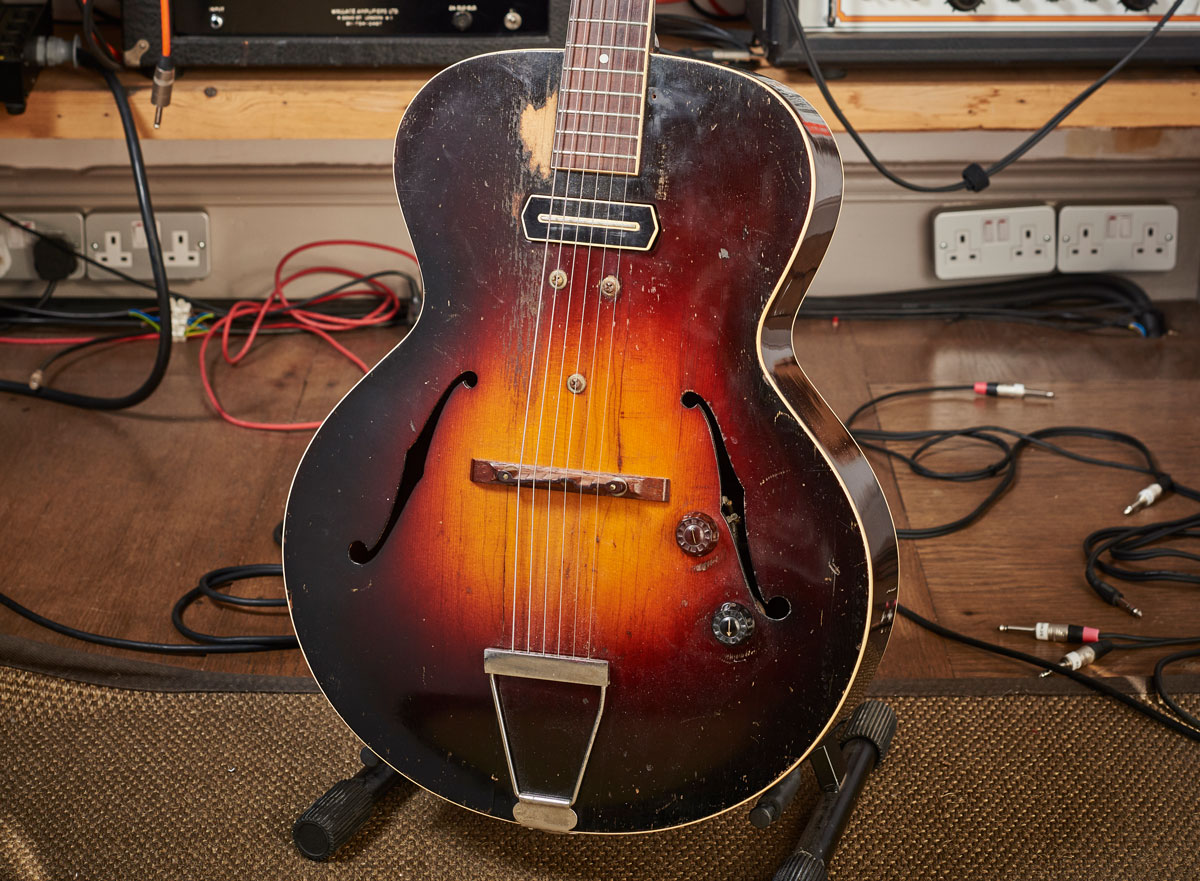
If the Frying Pan opened the door for the electric guitar, then the Gibson Guitar Corporation’s ES-150 blew the entire barn down. The ES stood for Electric Spanish and the 150 reflected how much the guitar cost ($150 with an amplifier). Gibson had tried getting electric guitars onto the market as early as 1933, but their early attempts were somewhat primitive.
Inspired by George Beauchamp’s revolutionary pickup for the Frying Pan, Gibson commissioned Walter Fuller to develop their own electromagnetic pickup that would better Beauchamp’s. Within weeks, Fuller succeeded, managing to create what is now commonly known as the “blade pickup,” which is still coveted by jazz players today.
Guitarists flipped their lid for the hollow-body guitar, and early players included legends like Eddie Durham, Floyd Smith and the most famous of them, Charlie Christian, who gave the ES-150 “near mythical status.”
9. American swing guitarist George Barnes makes the first commercial recording of an electric guitar in sessions with blues artist Big Bill Broonzy (March 1, 1938)
Many of you – okay, all of you – are probably unfamiliar with the name George Barnes, but back in the 20th century, he was a pretty big deal. According to Musician Union files, Barnes played on more recording dates for more people than any other guitarist in history, appearing on some 100 blues records in the 1930s alone.
His session career continued to thrive for the next two decades, appearing on another couple hundred albums, including those recorded by Frank Sinatra, jazz legend Louis Armstrong and country artists Homer & Jethro. He was even the first person to play an electric guitar on a Bob Dylan recording (the unreleased 1962 track, Mixed-Up Confusion).
But when he’s mentioned these days, it’s usually because he was arguably the first to record with an electric guitar, namely on Big Bill Broonzy’s vibrant 1938 classic, It’s a Low-Down Dirty Shame. Barnes rips it up with a collection of dazzling jazzy licks that are both electrified and electrifying.
While most players in the 1940s were thrilled with Gibson’s groundbreaking ES-150 (see Number 8), radio personality and superstar guitarist Les Paul was less than impressed. At higher volume levels the 150 was prone to feedback, which annoyed the heck out of him, so sometime in 1939 Paul started messing around with an idea that began with the 1932 Ro-Pat-In Electro A-25 “Frying Pan” – a solid body guitar.
10. Les Paul begins work on “The Log” solid-body electric guitar (1939)
Going back to square one, Paul started with a 4-x-4-inch slab of pine, roughly the length of a conventional archtop guitar body, attached a bridge, two wood-covered pickups that he made himself, and then hand-crafted vibrato tailpiece.
He then attached “wings” to both sides of the block to make it look and feel more like a conventional guitar. To his delight, when he finally plugged it in, it sounded pretty good – and it didn’t feed back.
Les was elated with his invention, which he nicknamed “The Log,” but when he brought the guitar to Gibson in 1941, they laughed at his “broomstick with a pickup.” Little did the company know, a decade later, Les would get the last laugh when a refined version of his signature “broomstick” would become one of the most revered guitars of all time.
11. The Fender Electric Instrument Company is launched (1946)
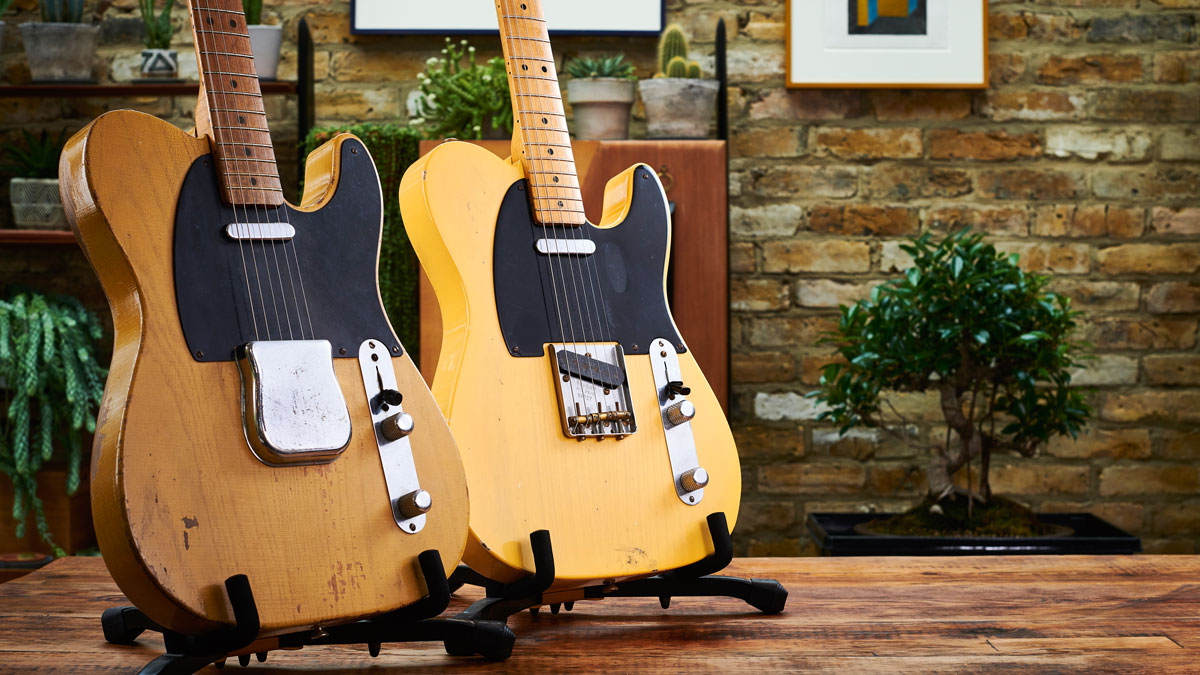
Back in 1938, an electronics technician named Leo Fender opened a humble repair shop where he fixed broken radios, phonographs, instrument amplifiers and just about anything else with wires. However, after several years, Leo grew restless and became convinced that manufacturing would be more profitable than repair, and as an experiment he built a lap steel guitar in 1946 for country virtuoso Noel Boggs. Boggs was thrilled with it, which inspired Fender to go into the electric guitar making business.
Ironically, Fender never played an instrument himself, but he loved country music (and hanging out with musicians), and during the late Forties, he started focusing on more conventional guitar designs, building his first solid-body Esquire in March 1950, followed shortly afterwards by the Broadcaster in the fall of 1950. A trademark conflict with Gretsch led the Broadcaster to being renamed the Telecaster in 1951, and the rest is, as they say, history.
Perhaps the single most radical thing about Leo’s Tele was the way the neck was attached to the body by means of four common bolts. It essentially disrupted several centuries of guitar making tradition, which stipulated that the only way to attach a guitar neck to the body was via a dovetail joint. Many guitar makers of the day sneered at the Tele for that reason, but it was a brilliant innovation that made the guitar more affordable and easily repaired.
12. The single Lover debuts Les Paul’s “New Sound” (1947)
It’s a popular misconception that Les Paul single-handedly invented the electric guitar, or at least the solid-body electric guitar. While he contributed substantially to the instrument’s development, he most certainly did not invent the solid-body electric guitar, much less the electric guitar itself. However, there are several important guitar-related innovations that can be attributed to him.
Les loved to tinker, and for that reason he built his own recording studio in his Los Angeles garage. It was there he began to make some of earliest known multitrack recordings, using not tape but a disc-cutting lathe he built with flywheel from a Cadillac and outfitted with multiple cutting heads.
The result of this grand experiment was the extraordinary 1948 hit song Lover, a tour de force featuring a staggering eight electric guitar parts, all played by Paul. The recording would go on to provide inspiration for Jimi Hendrix, Brian May and Jeff Beck, who told Guitar World, “It still sounds fresh today compared to most contemporary music.”
13. Muddy Waters creates modern electric blues (April 1948)
Muddy Waters set in motion the blueprint for the modern electric blues and rock with his two landmark recordings, I Can’t Be Satisfied and I Feel Like Going Home, featuring his bottleneck slide on an amplified guitar supported by a driving rhythm section.
This revolutionary new electric sound eventually inspired and gave birth to bands like the Yardbirds, Led Zeppelin and the Rolling Stones (who took their name directly from Muddy’s classic Rollin’ Stone).
14. The release of Rocket 88 by Jackie Brenston and his Delta Cats, arguably the first record featuring intentional guitar distortion (March 1951)
Rocket 88 was not a particularly original song, but there was one element that made the track stand out from the rest. It was driven by something few people had ever heard – a raucous, distorted guitar sound.
Producer Sam Phillips remembered, “the bass amplifier fell off the car. And when we got it in the studio, the woofer had burst; the cone had burst. So, I stuck a newspaper and some sack paper in it, and that’s where we got the sound.”
Phillips loved the unconventional tone and apparently so did millions of music fans. Rocket 88 soared to the top of the charts and became the third-biggest rhythm and blues single in jukebox plays of 1951.
15. The Fender Precision Bass is introduced and is the first electric bass to earn widespread attention (1951)
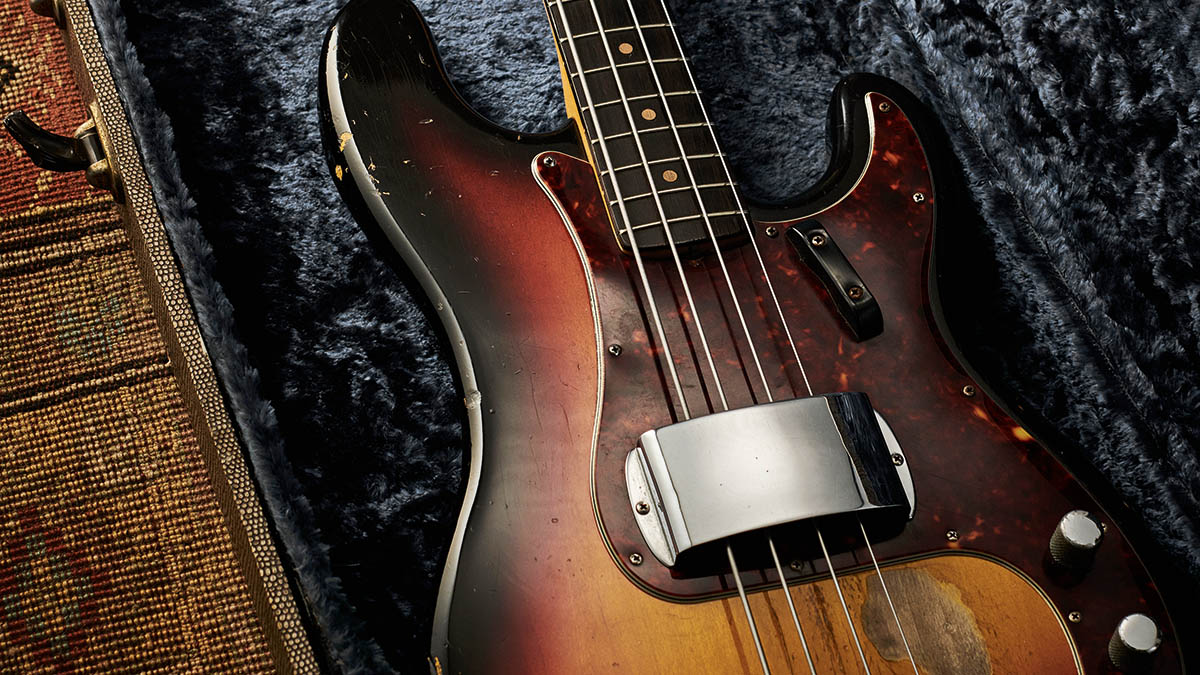
Before the invention of the Fender Precision, bassists had to lug around a physically cumbersome upright double bass. Besides making clarinetists snicker, the upright bass had other drawbacks. It was hard to hear in large band settings and the fretless fingerboard made it difficult for bassists to stay in tune.
The Precision Bass, or “P-Bass,” designed by Leo Fender in 1950, was created to specifically overcome most of those issues. And because he did his job so well, the venerable Fender four-string is still among the best-selling and most-imitated electric basses in popular music.
16. The Gibson Les Paul solid-body electric guitar is introduced (June 1952)

Les Paul – there’s that name again. But here’s the weird thing: He had very little to do with the instrument that bears his name. The guitar we all know and love today was actually created by Gibson factory manager John Huis and his team with some minor adjustments by Paul.
Gibson Guitar president Ted McCarty essentially approached the guitarist for the right to imprint his name on the headstock with the idea that his visibility as a recording star would help sales. Think of it as one of the first guitar endorsement deals.
Les was intrigued, and in 1951, Gibson presented him with a nearly finished instrument for approval. McCarty later stated that the design discussions with Les were limited to the tailpiece and choices of wood.
The 1952 Les Paul model ended up featuring a 1 ¾-inch thick mahogany body with a maple cap, a mahogany neck with a rosewood fretboard, two P-90 single coil pickups and a one-piece trapeze-style bridge/tailpiece with strings fitted under a steel stop bar.
While Paul was not completely satisfied with the finished goldtop instrument, he dutifully presented it to the public for the first time onstage in June 1952 at the Paramount Theatre in New York.
17. The Fender Stratocaster is introduced (1954)
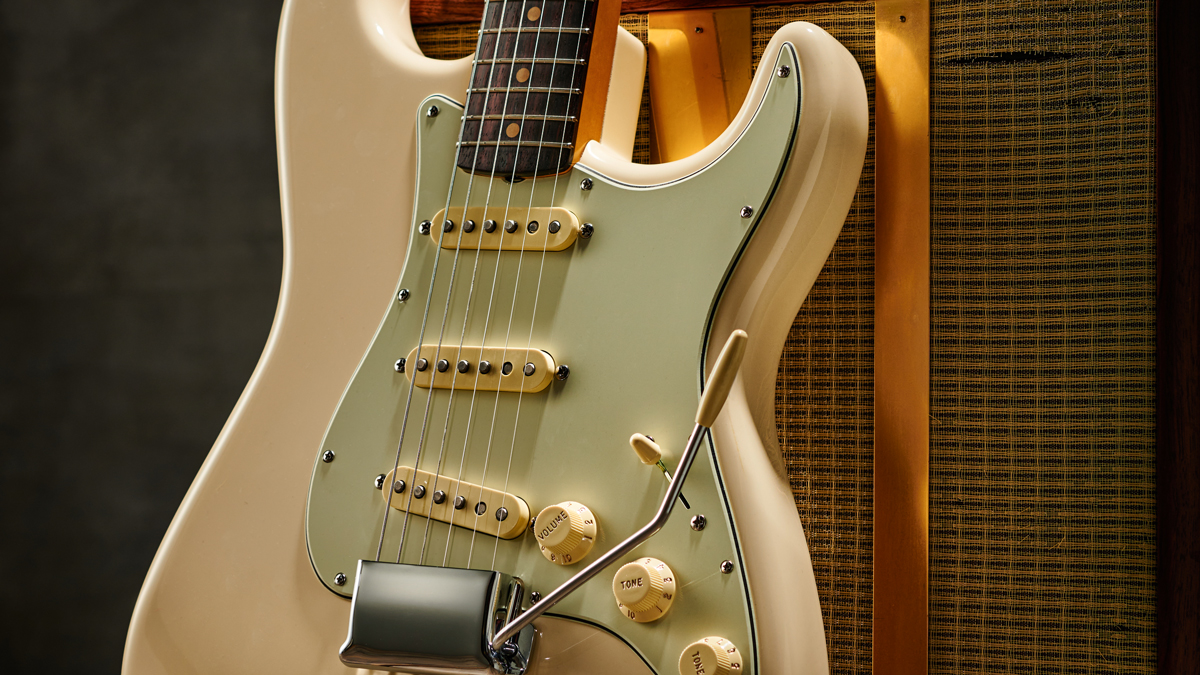
After Fender unleashed the Telecaster in 1951, Gibson responded with their upscale Les Paul. Not to be outdone, Leo Fender went back to the drawing board to create a fancy-schmancy instrument of his own.
The Stratocaster was the first Fender guitar to feature three pickups and a spring tension vibrato system, as well as being the first Fender with a contoured body. The sexy contoured body shape differed from the flat squared-off design of the Telecaster, and the Strat’s double cutaways allowed players easier access to higher positions on the neck.
The guitar was an instant smash and has often been referred to as the “best selling guitar of all time.” While that may or may not be true, suffice it to say it has received a big “thumbs up” from players like Jimi Hendrix, Eric Clapton, Jeff Beck, David Gilmour, the Beatles and Yngwie Malmsteen… and probably you.
18. The invention of the humbucking pickup (1957)
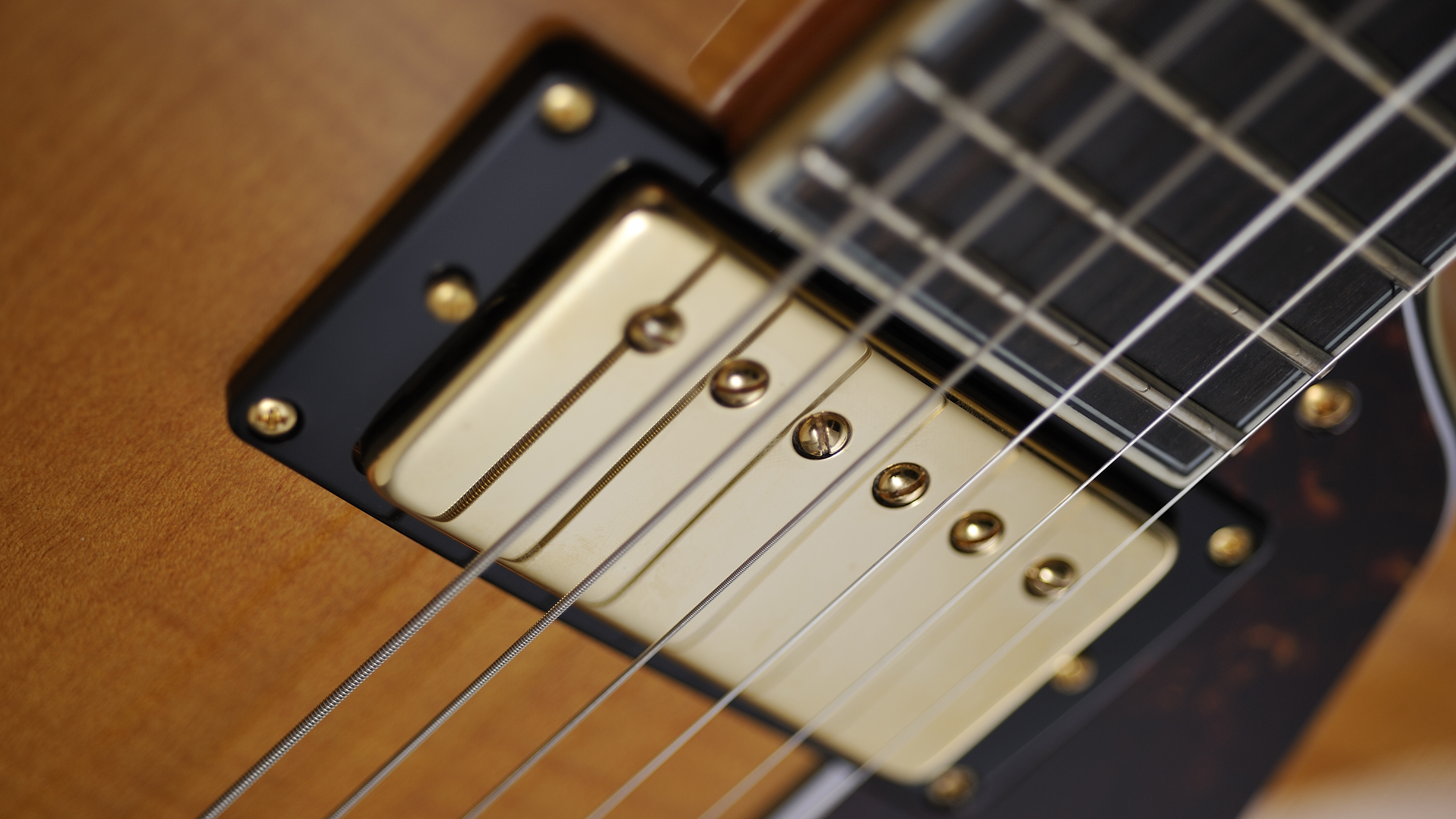
Since the 1930s there had been an inherent problem in guitar pickups, namely that dirty word that begins with an “h” and ends with an “m.” No, not that word. Jeez… get your mind out of the gutter! We’re talking about that bothersome buzz known as 60-cycle hummmmm.
Because the problem was so pervasive and annoying, during the mid 1950s there was something of a space race between Gibson and Gretsch to see who could solve the issue first. History shows that Gibson won the battle when Seth Lover created his immortal PAF (Patent Applied For) humbucking pickup. But Gretsch didn’t go down without a fight.
Around the same time, Ray Butts developed a similar pickup for Gretsch known as the Filter’Tron humbucker. Although Gibson’s patent was filed almost two years before Gretsch’s, Gibson’s eventual patent was issued four weeks after Gretsch’s. Still, the Gibson Les Paul Model and Les Paul Custom were the first guitars to use humbuckers in substantial production, so the invention tends to be thought of as their innovation, to which Ray was rumored to say, “Ain’t that a kick in the Butts!”
19. Chuck Berry records the ultimate guitar anthem, “Johnny B. Goode,” using his Gibson ES-350T (January 6, 1958)
With his 1958 masterpiece, Johnny B. Goode, Chuck Berry created the ultimate rock ’n’ roll folk hero in just a few snappy verses. As we all know, Goode wasn’t pounding a piano, singing into a microphone or blowing a sax.
In his choice of the electric guitar – something sleek and of the moment – the fictional character of Goode would forge an image of the archetypal rocker, doing much to shape the history of the instrument as any real-life figure ever has.
The song’s opening riff is a clarion call – perhaps the greatest intro in rock ’n’ roll history. It was played by Berry on an electric Gibson ES-350T, and it indeed sounded “just like a-ringin’ a bell.” To teenage ears, Berry’s guitar signaled the dawn of an exciting new era – one that would use six-strings and an amp as its primary soundtrack.
20. The Vox AC15, the first tube amp featuring “overdrive” (1958)
Americans weren’t the only ones building electric guitars and amps. As we shall see, the Brits made their fair share of contributions to our favorite instrument, starting with the much-overlooked Vox AC15 amplifier. In the late 1950s distortion was considered a problem, and amp makers at the time usually eliminated it with the aid of a “negative feedback circuit.”
British engineer and guitar nerd supreme Dick Denney decided he didn’t like the effect the circuit had on his guitar sound and engineered his new Class A combo without the “party-pooper” electronics.
This allowed the onboard EL-84 tubes to be pushed into overdrive without removing the desirable even order harmonics, resulting in rich, natural-sounding distortion. The result? An amp that paved the way for the future.
21. The wobbly creation of the pointy guitar (February 21, 1958)
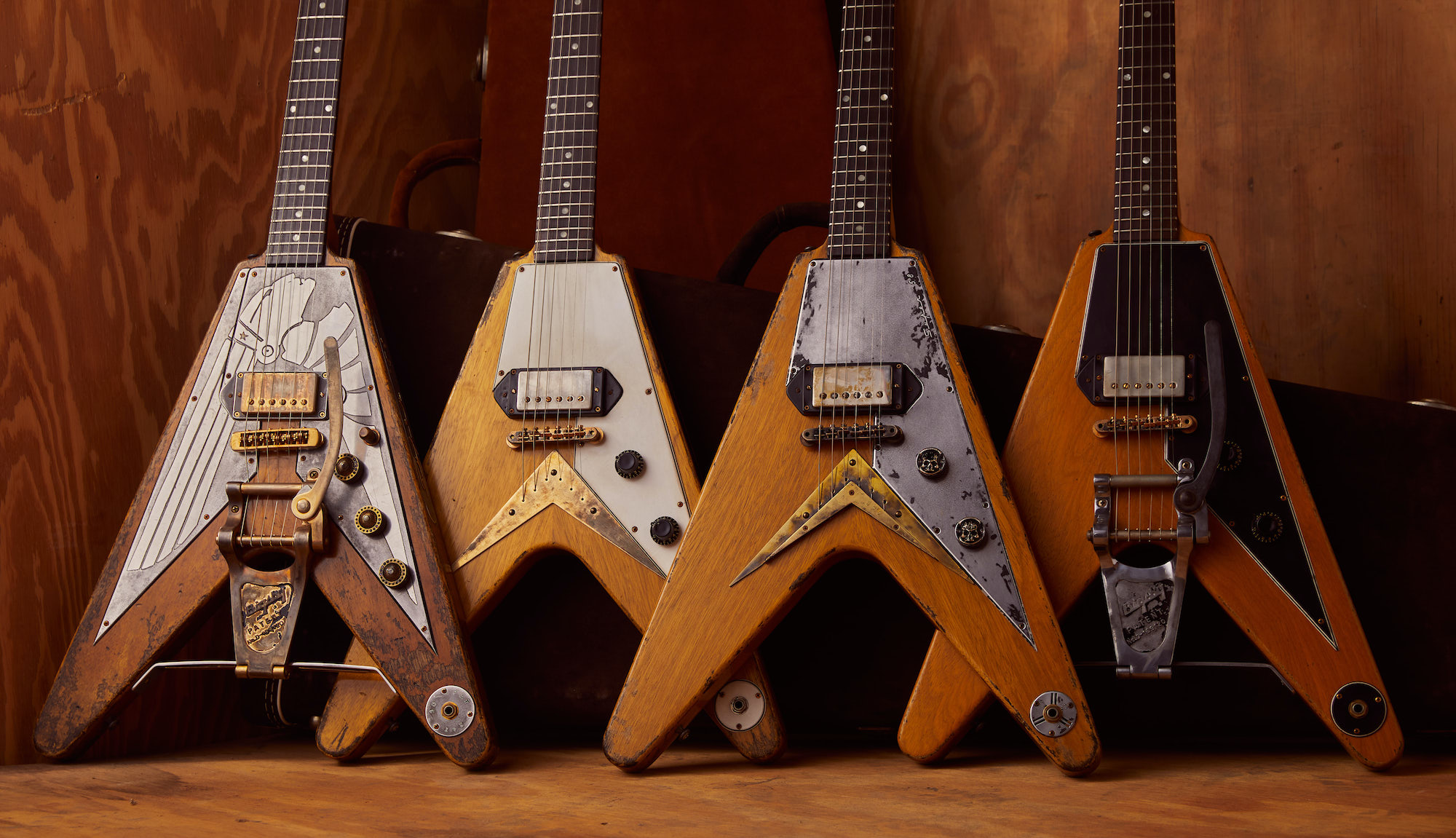
Just as Leo Fender had responded to Gibson’s Les Paul with his sleek and unconventional-looking Stratocaster, Gibson decided to strike back with no fewer than three wild-looking guitars designed to leave the Strat in the Stone Age – the Flying V, the Explorer and the Moderne.
Unfortunately, they were a little too ahead of the curve, and the V and the Explorer were commercial failures. Gibson quickly shelved the V and the Explorer, and the Moderne never even made it into production. But that wasn’t the end of their story.
By the dawn of the 1980s, the V and the Explorer went from being black sheep to iconic heavy metal guitar mainstays
Unbeknownst to Gibson, several important guitar influencers, including Albert King, Lonnie Mack and the Kinks’ Dave Davies, loved their V’s and were often photographed with their exotic instruments.
Sensing a trend, Gibson started producing Flying V’s again in 1968, this time with better sales. However, it took almost another decade before they began reissuing the Explorer after Hamer Guitars had success selling similar designs.
By the dawn of the 1980s, the V and the Explorer went from being black sheep to iconic heavy metal guitar mainstays, influencing countless “pointy” guitars designed by companies like Dean, ESP and Jackson.
22. Gibson is first to market with a mass-produced fuzz pedal, the Maestro FZ-1 Fuzz-Tone (1962)
What electric guitar player doesn’t love pedals? I have a friend who views them as sort of currency, as in, “Geez, I could’ve bought two and a half pedals with the money I spent on groceries this week.” Or, “With the dough I spent on those jeans, I could’ve bought an Electro-Harmonix Big Muff.”
If you’re a pedal enthusiast like my pal, you can thank Gibson’s Maestro FZ-1 for getting the ball rolling in 1962. Designed by recording engineer Glenn Snoddy (good name!) and WSM-TV engineer Revis V. Hobbs (an even better name!), the Maestro was the first commercially available fuzz box to gain widespread acceptance.

Like anything new, the FZ-1 got off to a slow start. What kicked it into overdrive – and guitar pedals in general – was when Rolling Stones guitarist Keith Richards used one to play the gnarly riff in the band’s 1965 mega-hit Satisfaction. Immediately, every garage rock and psychedelic act had to have one, causing Gibson to sell every unit they had in stock.
Sensing gold in “them thar hills,” fuzz pedals suddenly started sprouting like mushrooms on an Italian cooking show, including the Mosrite Fussrite, the Sola Sound Tone Bender and the classic Dallas-Arbiter Fuzz Face used by another maestro – Jimi Hendrix. After that, everything gets a little fuzzy.
23. Ernie Ball introduces Slinky strings .010-.046 (1962)
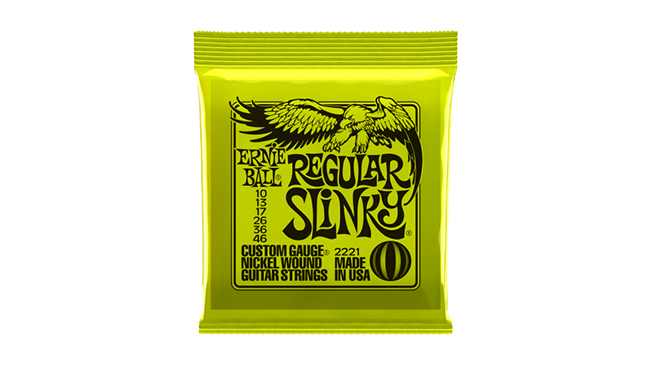
In the years before Ernie Ball introduced his revolutionary Slinky strings in 1962, guitar players who wanted to bend strings were a little screwed. They’d have to buy a set of regular electric guitar strings with a wound third and a .013 high E and make a choice.
They could either tune down a half-step to make the strings more bendable like Hendrix or Stevie Ray Vaughan. Or they could buy a new set, throw away the low E string, and move the rest of strings down and replace the high E with a super-light banjo string like Jimmy Page and Johnny Winter.
Thank your lucky stars a music store owner named Ernie Ball had the brains to stop the madness. He noticed young players were struggling to press down the wound third strings, which were “like a giant cable,” and reported the problem to Fender, asking one of the company’s sales reps to talk to Leo Fender himself. The rep returned with the news that Leo was not interested in making lighter-gauge strings because the lighter strings would force him to re-engineer his guitars to compensate for the different tension.
Ball knew a solid “fuck you” when he heard one, so he contacted an independent string manufacturer and had custom gauge sets produced with light, 24-gauge third string, which eventually led to the creation of Slinky strings in 1962. Ya gotta hand it to Ernie – the dude definitely had balls.
24. The Beatles make their U.S. television debut on The Ed Sullivan Show. George Harrison performs on a Gretsch Country Gentleman and John Lennon plays a Rickenbacker 325 (February 9, 1964)

There are millions of reasons why the Beatles were important, but if you ask me, their biggest contribution to music was creating the near-perfect formula for the modern rock band. In fact, it’s rumored that when John Lennon sang All You Need Is Love, what he really meant to say is, “All you need are two electric guitars, a bass and a drummer.” It just wasn’t as catchy.
Apparently, the kids understood what he meant, anyway. In 1964, an estimated 73 million people gathered in front of their television to gawk at John, Paul, George and Ringo laying it down on Ed Sullivan in front of a theater of teens going ape shit.
The next day, thousands of those little dirt bags – including Gene Simmons, Joe Perry, Bruce Springsteen, Tom Petty and Nancy Wilson – ran out and bought guitars and started bands. The message had been received.
25. The Who’s Pete Townshend smashes his guitar for the first time, onstage at the Railway Hotel, London (1964)
Pete Townshend was one of the first rock musicians to realize the guitar could be used for something more than just shredding solos or writing songs – it could also serve as the ultimate stage prop.
During a typical performance by the Who, Townshend would pose, jump, windmill and throw his guitar into the air in dramatic fashion while playing some of the most exciting music of the 1960s and 1970s. And if he couldn’t think of anything better to do, he’d simply smash it, which was fine, too.
26. The first Marshall 100-watt amp is created at Townshend’s behest (1965)

We’ve just established that Townshend had a flair for the dramatic, so is it any surprise that he was one of the prime instigators behind the creation of the monolithic, mega-loud 100-watt Marshall stack? It all started when London-born big band drummer Jim Marshall opened a drum shop in London in 1960. At the urging of local rock musicians who frequented his shop, among them Townshend, he soon expanded into the sale of other musical instruments, including electric guitars and amps.
Pete was one of the ones who came to me and said, ‘In the music shops of West London they treat us like idiots because we play rock ’n’ roll. So why don’t you sell amplifiers and guitars in your shop?
Jim Marshall
“Pete was one of the ones who came to me and said, ‘In the music shops of West London they treat us like idiots because we play rock ’n’ roll. So why don’t you sell amplifiers and guitars in your shop?” recalled music store owner Jim Marshall. “I said, ‘Well, I know a lot about drums but not guitars and amps. But I’ll have a go at this.’ I did and it was successful right from the word go.”
Marshall then took it one step further and started designing and producing his own custom line of amps, starting with the classic 30-watt 1962 Marshall JTM45. But that wasn’t quite enough for Townshend, who was looking for even more volume. In 1965, the Who guitarist demanded that Jim build him the ultimate rock monster, a 100-watt behemoth that ultimately enabled him, Eric Clapton, Jimi Hendrix, Eddie Van Halen and others to generate feedback, doomsday distortion and enough volume to reach the furthest corners of any club or arena.
27. Brian May builds his Red Special guitar (1963-1964)
Years before Edward Van Halen built his Frankenstein or Steve Vai designed his Ibanez JEM, Queen’s Brian May hand-crafted his one-of-kind Red Special heard on songs like Bohemian Rhapsody and Stone Cold Crazy. May’s DIY instrument sent a message to guitarists everywhere: If you can’t buy what you want, pull up your satin bellbottoms and make one yourself.
Constructed from wood from a “hundred-years-oldish” fireplace mantel, the guitar features three single-coil pickups and a custom-made aluminum bridge. The tremolo system was constructed from an old hardened-steel-knife-edge shaped into a V and two motorbike springs to counter the 79 pounds of string tension.
“My father and I designed the instrument from scratch, with the intention that it would have a capability beyond anything that was out there: more tunable, with a greater range of pitches and sounds, with a better tremolo and with a capability of feeding back through the air in a good way,” May said. Mission accomplished.
28. Blues Breakers: John Mayall with Eric Clapton, is released, ushering in a new era of guitar heroics (July 1966)
Longtime Guitar World contributor Alan di Perna once hailed Blues Breakers as “one of the most important guitar recordings of all time – kind of like Sgt. Pepper’s Lonely Hearts Club Band for guitar players.”
The reason? There are many. In addition to playing the blues with a cocky rock ’n’ roll aggression, Clapton was the first to record with the magical combination of a Les Paul Standard plugged into one of Jim Marshall’s recently invented 1962 JTM45, 30-watt amplifiers. His virtuosity combined with the amp turned up full volume turned the guitar-playing world on its head, inspiring future superstars like Jimi Hendrix, Duane Allman and Stevie Ray Vaughan to do the same.
“I was trying to emulate the sharp, thin sound that [bluesman] Freddie King got out of his Gibson Les Paul, and I ended up with something quite different, a sound that was a lot fatter than Freddie’s,” Clapton said. “I would hit a note, hold it and give it some vibrato with fingers, until it sustained and then the distortion would turn into feedback. It was all of these things, plus the distortion that created ‘my sound’.”
And it was a sound like thunder. No wonder shortly after people started calling Clapton “God.”
29. The first wah-wah pedal is created by Warwick Electronics Inc./Thomas Organ Company (November 1966)
The invention of the wah pedal is a rather long and confusing tale, so we’ll try to give you the short version, which shouldn’t be confusing at all. It begins when a young engineer named Brad Plunkett was tasked by Thomas Organs to take apart a British Vox AC100 guitar amp and find a way to make it cheaper to produce while still maintaining the sound quality.
Thomas had made a deal to distribute Vox in the U.S., and they were looking to save a few bucks along the way. Somewhere during the process Plunkett succeeded in designing a new circuit that could change the frequency of notes by simply rotating a potentiometer.
“I asked a friend of mine to plug a guitar into this pile of wires, resistors and capacitors I had on a bench,” Plunkett said. “He strummed a few chords while I turned the knob on the potentiometer, and it went ‘wah-wah-wah.’ I thought, ‘Wow! This is really great!’”
Initially, the company thought the effect would be great for trumpets and other wind instruments, but when guitarist and Vox employee Del Casher stumbled upon Plunkett’s early prototype, he recognized its incredible potential for the guitar and convinced upper management to market it to the six-string nerds.
Almost immediately after being released in 1966, the chief six-string nerd, Frank Zappa, bought one and spread the word to his guitar compadres, like Eric Clapton and Jimi Hendrix. As Hendrix told reporters, “It’s got a very groovy sound.” And everyone that heard Clapton use it on Cream’s White Room, or Hendrix on Voodoo Chile (Slight Return) agreed… the wah was, indeed, groovy.
30. Guitar Player, a popular magazine for guitarists, is founded (1967)
A magazine? Just for guitarists? Now, that’s just ridiculous…
31. The release of Are You Experienced, the debut album by the Jimi Hendrix Experience (May 12, 1967)
When Are You Experienced hit the record stores, it was like a transmission from Jupiter. If Eric Clapton had discovered a way to make the guitar sound larger (see Number 28), Jimi changed just about everything else.
From the proto-metal of Foxy Lady to the wild psychedelic blues of Red House to the phantasmagorical studio trickery of Third Stone from the Sun, it felt like Jimi was reinventing and reimagining the electric guitar with every song… or perhaps every note.
As British rock journalist and guitar aficionado Charles Shaar Murray noted, the album “completely changed notions of what guitar could sound like, or indeed, what music could sound like.” Revolutionary.
32. Jimi Hendrix closes the Woodstock Music and Art Fair with a set that includes “The Star-Spangled Banner” (August 18, 1969)
If a poll were taken to determine the single most influential electric guitar performance in the instrument’s entire history, the majority of votes would most likely go to Jimi Hendrix’s astonishing performance of The Star-Spangled Banner at Woodstock.
By taking the well-known hymn to American battle victory and inserting explosive whammy bar dives and high-pitch squeals to emulate human cries of agony, Hendrix used his guitar to plunge his listeners into the chaotic and disquieting sonic reality of battle itself.
Hendrix, who had served in the military, understood the horror, grief and valor associated with war, and knew that what he wanted to express was beyond words, so he let his guitar do the talking instead. Miraculously, he transformed his Fender Stratocaster into an instrument of political commentary and social change – and everyone understood.
33. Gruhn Guitars opens in Nashville, becoming the flagship for the burgeoning vintage guitar market (January 2, 1970)
Is it weird to start the section on modern times with an entry about vintage guitars? Definitely. But the truth is, the idea of sky-high price tags on old instruments is a rather new construct.
In the 1970s, American guitar manufacturers had gotten sloppy, cutting corners on the construction of new guitars. This development led to musicians to reassess older instruments and to their surprise, smart guys like Joe Walsh (Eagles) and Rick Nielsen (Cheap Trick), discovered they were damned good.
But the man perhaps most responsible for spreading the gospel of vintage was George Gruhn, owner of the world-famous Gruhn Guitars in Nashville. Gruhn opened his first shop specializing in used and older guitars in 1970.
“Back then there weren’t any stores nearby that were selling vintage instruments,” Gruhn said. “And serious musicians weren’t interested in new stuff because it was all crap; 1970 was a low, low point for new-instrument quality. So we met Crosby, Stills, Nash & Young, Bob Dylan, Joni Mitchell, Eric Clapton, Duane Allman… you name it.”
From that point on, the mystique of classic instruments just grew and grew, as did Gruhn’s shop. Gruhn Guitars now resides in a three-story building at 2120 8th Ave. South in Nashville, and visiting there can be overwhelming. But chances are, you’ll stumble upon something that is hipper and hotter than anything you’ll find at Guitar Center.
34. Black Sabbath and the invention of heavy metal (February 13, 1970)
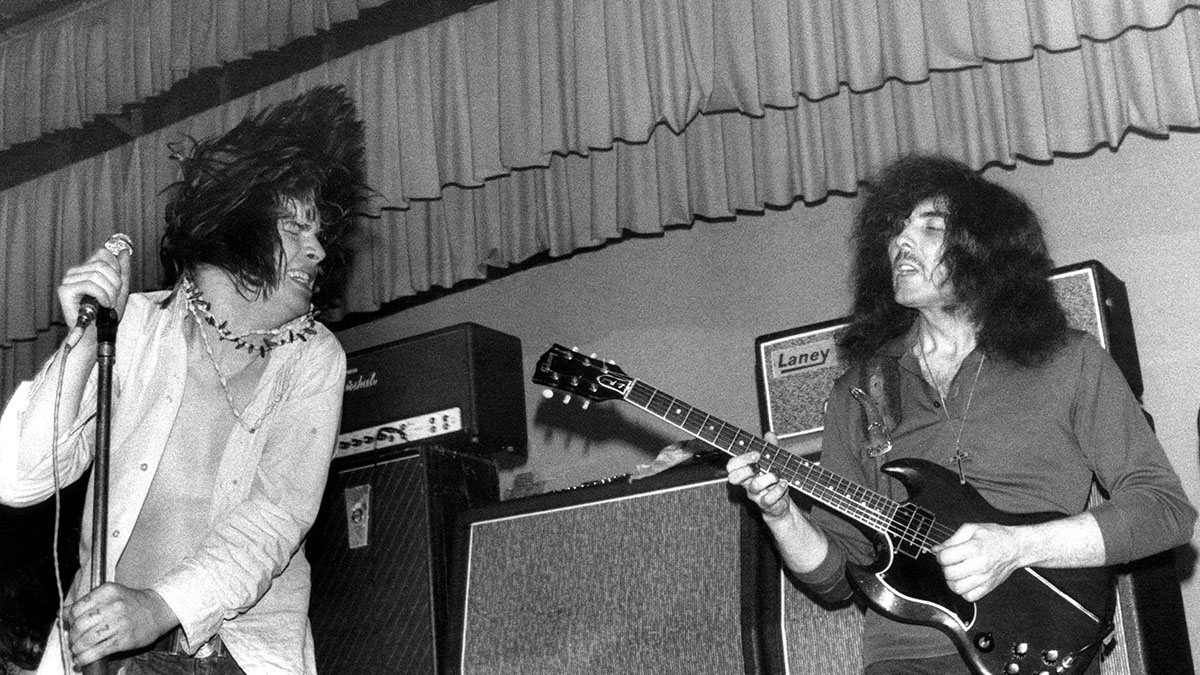
No other genre of music has done as much to keep the electric guitar alive and chug, chug, chugging along than heavy metal. But one thing that bands like Ghost, Polyphia, Lamb of God or Apes all have in common is they owe some debt of gratitude to the OG’s of metal, Black Sabbath.
Recorded in a single 12-hour session on October 16, 1969, Black Sabbath’s debut is widely regarded as the first heavy metal album. Central to the band’s innovative heavy sound was guitarist Tony Iommi’s detuned guitar. Much of his new sound was developed after an accident at a sheet metal factory in which the tips of the middle fingers of Iommi’s fretting hand were severed.
Determined to keep playing guitar, he created a pair of false fingertips using plastic from a dish detergent bottle and detuned the strings on his guitar to make it easier for him to bend strings. The result was a gigantic new guitar tone.
His impairment also limited his note choices, forcing him to concentrate on building his compositions around power chords and parallel fifths, which also became a hallmark of heavy metal.
“I’d play a load of chords and I’d have to play fifths because I couldn’t play fourths because of my fingers,” Iommi said.
While critics of the day dismissed Black Sabbath’s music as “bullshit necromancy,” there is no doubt the band’s music and influence will live on long after we’re all six feet under.
35. Led Zeppelin releases IV, featuring Stairway to Heaven (November 8, 1971)
For every “yin” there’s gotta be a “yang,” and if Black Sabbath opened up a metal stairway to hell with songs like Paranoid, then leave it to Led Zeppelin to respond by constructing a celestial Stairway to Heaven. Yes, there are two paths you go down in the long run, and there’s still time to get tossed out of your local music store by playing a shitty version of either.
36. Larry DiMarzio builds and markets his first Super Distortion pickup, kicking off the replacement-parts revolution (1972)
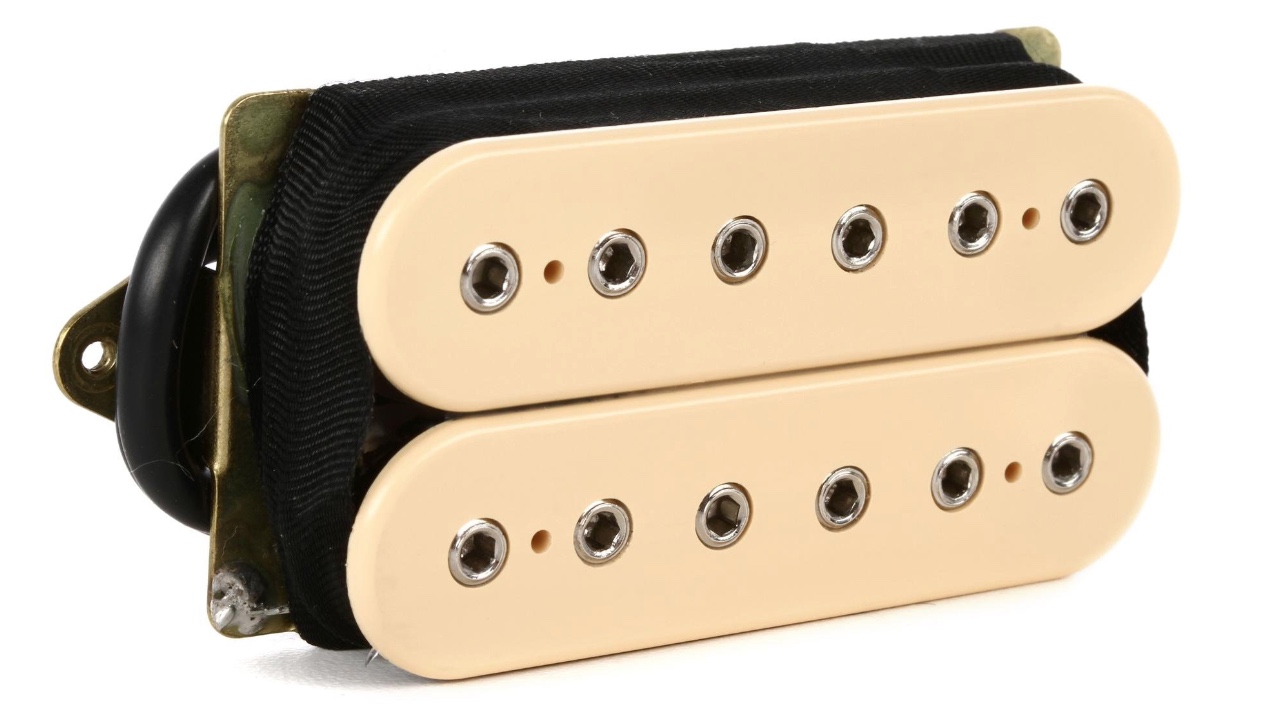
One of the inevitable results of the decline of guitar manufacturing in the 1970s was the creation of the “aftermarket replacement parts” industry – an unsexy name for a resourceful group of independent tinkerers who started making guitar parts and accessories that improved inferior factory-made instruments.
Leading the charge of this revolution was a young Staten Island, New York, musician and guitar technician named Larry DiMarzio, who built his first Super Distortion pickup as a replacement for factory Gibson humbuckers in 1972.
“I started building my own pickups for the most practical reason,” DiMarzio says. “I wanted my guitar to sound better. I wanted to get a bigger sound than what I was getting out of the standard pickups of the day. It turned out others did, too.”
37. A 19-year-old Paul Reed Smith sells two of his earliest handmade instruments to Ted Nugent and Peter Frampton (1976)
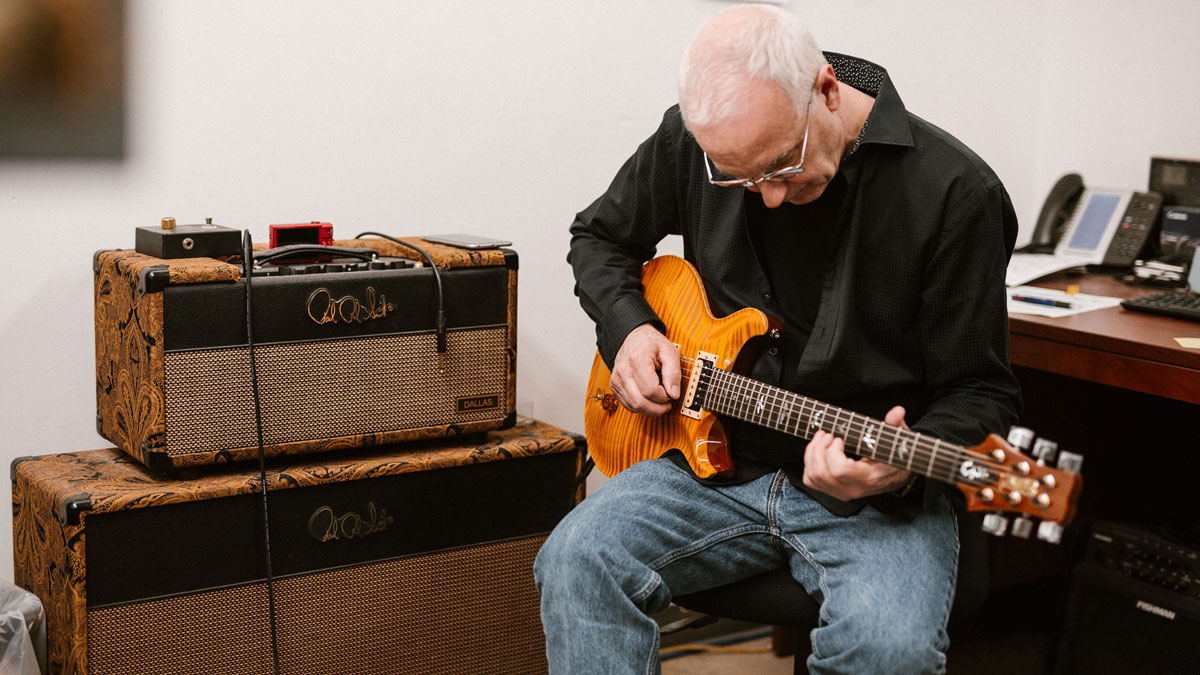
Paul Reed Smith heard destiny calling early. At 16 he started tinkering with guitar building in high school woodshop, but by his senior year it had become something of a full-blown obsession, when he landed part-time work as an instrument repairman at Washington Music Center in Maryland.
During his employment, he was often shocked by what he saw. It was one thing to fix an older instrument that had fallen into disrepair, but more often than not he was being asked to fix up brand-new instruments that had been shipped directly from factories.
“I saw an opportunity,” he said. “I didn’t see myself as somebody who was going to change the guitar industry, but I could see how I could make a difference by doing things right.”
I didn’t see myself as somebody who was going to change the guitar industry, but I could see how I could make a difference by doing things right
Paul Reed Smith
And that’s exactly what he did. In 1976 he built some of his earliest guitars for “Motor City Madman” Ted Nugent and Peter Frampton, and word began to quickly spread among the guitar elite about this young genius from Maryland and his spectacular instruments. Ten years later he founded PRS Guitars, and his continued commitment to excellence made him one of the biggest and most respected guitar manufacturers in the world.
“It was Paul Reed fucking Smith that forced Gibson and Fender to get back into the game,” Nugent said. “In the late 1980s, they realized this kid was kicking their ass, and they finally started making really good guitars again.”
38. Eddie Van Halen constructs his first “Frankenstein” guitar (1976)
If you’ve been paying attention to the last four for five entries, you’ve probably noticed a theme – namely American guitar companies like Fender and Gibson hit a rough patch in the 1970s.
The decline in quality was due primarily to corporate takeovers that tried to maximize profits by cutting corners on quality, and as we’ve seen, dudes like Larry DiMarzio and Paul Reed Smith were none too happy with the situation. And you can add one more name to that list: a young Dutch kid named Eddie Van Halen, who couldn’t find anything that sounded “right” to his ears.
His solution was the same as theirs. He took matters into his own hands. By grabbing various parts from guitars he liked – a Gibson humbucker here and a Strat vibrato system there – and slapping them on a replacement ash body from a local shop, he cobbled together arguably the most iconic guitar in the history of rock ’n’ roll and the true prototype for the uber-popular super Strat.
“People tripped out on that, but I’d try anything to make something work,” laughed the late Eddie Van Halen. And that’s one guitar lesson worth learning.
39. Guitar World is launched (1980)
Another magazine just for guitarists? Now, that’s just ridiculous…
40. Boston guitarist Tom Scholz invents the Rockman, and the “amp simulator” is born (1982)
Most players probably think amp simulators are relatively new inventions, but they’re as old as Boston – the band, that is.
Tom Scholz, the guitar genius behind Boston hits like More Than a Feeling and Don’t Look Back, was an MIT-trained engineer, and in 1982 he started his own guitar technology company Scholz Research & Design. His first product was the Rockman headphone electric guitar amplifier, a remarkable unit that could also plug directly into the mixer on stage or in a studio, effectively making it a DI box for many guitarists.
In many ways, it became the sound of the 1980s and was used almost exclusively by Def Leppard on their groundbreaking Hysteria album, and by artists Joe Satriani and Megadeth.
The Rockman was an innovative idea, but it took a while for other companies to catch on, starting with Tech 21’s iconic 1989 SansAmp. Today, digital amp simulation and its more sophisticated big brother, amp modeling, are more prevalent than ever, with the Kemper Profiler and Fractal Audio’s Axe-FX leading the charge. But it all goes back to the brainiac from Boston, the wicked-smaht Scholz.
41. Beat It – written and performed by Michael Jackson, featuring Eddie Van Halen on lead guitar – is released. Its music video is often credited as paving the way for Black artists on MTV (March 31, 1983)
When MTV made its debut at 12:01 a.m. Eastern Time, Saturday, August 1, 1981, it was launched with the words, “Ladies and gentlemen, rock and roll.” And for the next couple of years that was its focus – rock ’n’ roll. Specifically, rock ’n’ roll performed by white artists like Def Leppard, Billy Idol and Van Halen.
As the music channel exploded, naturally popular Black r&b and hip-hop musicians started feeling left out, if not downright discriminated against. And rightly so. Still, the executives at MTV were happy with the way the channel was being received and mostly turned a deaf ear.
It wasn’t until Michael Jackson’s Beat It, featuring a chugging heavy metal riff recorded by Steve Lukather and topped with a spectacular solo by Eddie Van Halen, that the music channel began to see that Black music could and should be an essential part of their mix.
Shortly after, MTV opened the door for Jackson, and other African-American artists like Prince, Whitney Houston, Tina Turner, Lionel Richie and Run-DMC, and the music world was a much better place for it.
42. Stevie Ray Vaughan releases Texas Flood, reinventing and reinvigorating electric blues (June 13, 1983)
Ever since Muddy Waters first plugged in his slide guitar in the late 1940s, the blues had played a major role in the continuing story of the electric guitar. But by the 1980s the genre started feeling antiquated, especially when compared to the fireworks generated by rockers like Van Halen, Randy Rhoads and Steve Vai.
With Texas Flood, Stevie Ray Vaughan changed that and almost single-handedly brought the blues back from the dead. By fusing the formalism of Eric Clapton with the wildness of Jimi Hendrix and adding a pinch of the virtuosic swagger found in 1980s hair metal, SRV made playing the blues hip again.
Despite his premature death in 1990 at age 35, the Texas guitarist can be credited with paving the way for new generations of blues guitarists, including Joe Bonamassa, Eric Gales, Gary Clark Jr., Samantha Fish, Marcus King and others. The result is that the blues is/are still alive and well, and the scene is as vibrant as it’s ever been.
43. Metallica releases Kill ’Em All and reinvents heavy metal for the modern era (July 25, 1983)
Just as dozens of young Brits repackaged the music of Black American blues and sold it back to us as the Rolling Stones, the Yardbirds and Cream in the 1960s, three aggressive Americans (and a rather loquacious drummer from Denmark) returned the favor by stealing as much as they could from British metal bands like Judas Priest, Iron Maiden and Motörhead in the 1980s, making millions in the process.
Of course, Metallica put a little of their own spin on those influences by speeding up the tempos and making each rapid-fire power chord at least a pound or two heavier. And it was those slight variations that started a revolution that goes on to this day. The speed, power and agility of Metallica opened the door for Slayer, Megadeth, Anthrax, Testament and just about every metal band that came after them.
44. Ibanez introduces the Steve Vai JEM series (1987–1990)
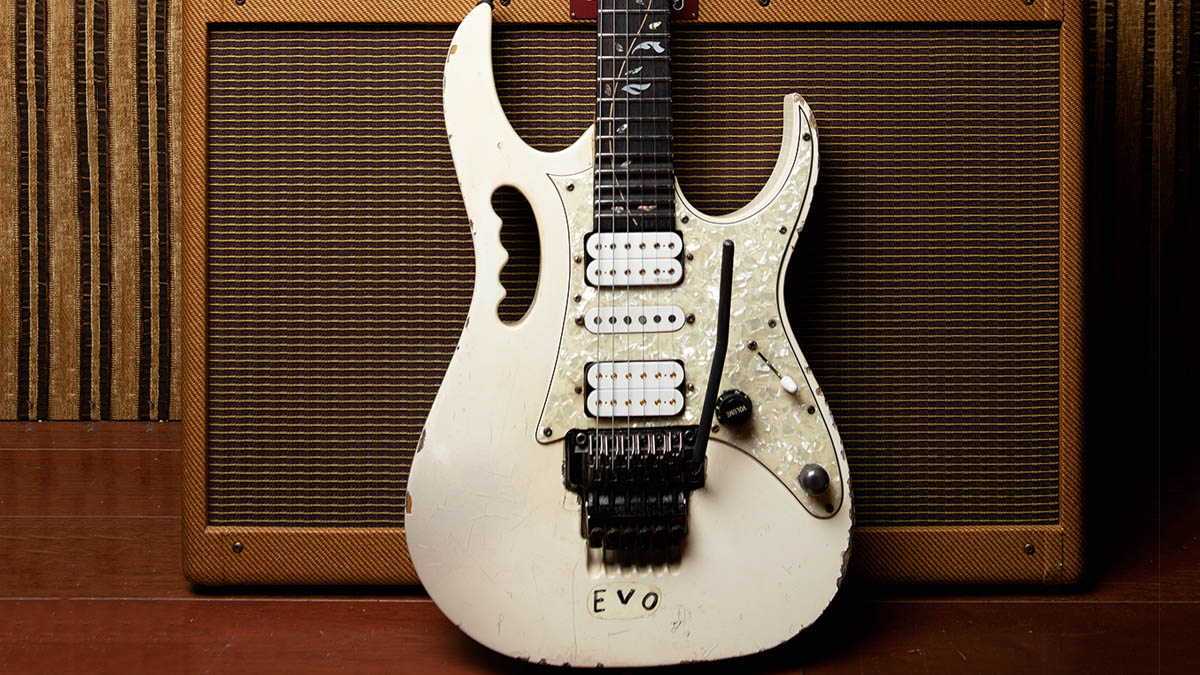
If all Steve Vai did was introduce a new level of virtuosity to the electric guitar via his groundbreaking work with Frank Zappa and his solo albums like Passion and Warfare, he would’ve deserved a place on this list as a game changer. But it’s perhaps his contribution to electric guitar design that will end up having the most lasting impact on the instrument.
While Eddie Van Halen tends to get the lion’s share of the attention for his innovative Frankenstein guitar, Vai’s signature JEM series is perhaps just as innovative and influential.
With features like a floating whammy bar, a 24-fret neck with a deeper cutaway, a yank-proof input jack, a combination of both humbucking and single-coil pickups for maximum tonal flexibility, and an all-important seventh string on his JEM Universe models, Steve’s Ibanez signature guitars are Ground Zero for all the new-school seven- , eight- and nine-string guitars that followed in its wake.
45. Buckethead releases his first album, ushering in new era of virtuosity (1992)
When Pomona, California, guitarist Brian Patrick Carroll, aka Buckethead, released his first album Bucketheadland on John Zorn’s Japanese Avant label, it elicited a collective gasp among guitar players.
First, there was his appearance – he only performed wearing an expressionless white mask topped with a KFC bucket on his head. While that was sorta freaky, it didn’t compare to otherworldly chops that made speedy players like Joe Satriani, Eddie Van Halen, Yngwie Malmsteen and Paul Gilbert sound like they were running in quicksand. With Bucketheadland, he took sheer blinding speed and technique to another level.
Since then, a new generation of equally astonishing guitarists have emerged, whose main purpose seems to be making other players cry, including Tosin Abasi and Javier Reyes (Animals As Leaders); Tim Henson and Scott LePage (Polyphia), Guthrie Govan and Andreas Varady.
46. Line 6 Amp Farm and the rise of software amp modeling (1998)
A bit more than 20 years ago – when most of us were just starting to come to grips with the idea of shoving our entire lives onto our laptop – some wise guy at Line 6 came up with the idea of stuffing a whole bunch of desirable amplifiers in there, too, and the Amp Farm licensed amp model collection was born.
These days plugins by companies like BIAS, Blue Cat, IK Multimedia and Line 6 are so damned omnipresent in recording studios, that you’re lucky if an engineer doesn’t escort you to the door if you roll up with a traditional head and a 4x12 cab.
When Guitar World spoke with John Mayer a couple of years ago, he said he still takes an amp with him when he does a session, but 99 percent of the time the producer will use the direct to digital track in the final mix. Are traditional amps toast? Who knows. But they are definitely getting a little brown around the edges.
47. Jack White of the White Stripes buys a vintage 1966 Montgomery Ward Airline guitar from Detroit musician Jack Yarber (aka Jack Oblivian) and revives interest in what many had considered “junk” guitars from the 1960s (1999)
Next time you wander into a NAMM Show and notice all these weird-looking guitars that look like vintage coffee tables and wonder where the hell they came from, thank (or blame) Jack White, who elevated the Airline guitar to retro icon status.
48. YouTube guitar instruction (2003)
Back in 2003, Australian guitarist, songwriter and educator Justin Sandercoe had a swell idea: Why not offer a few guitar lessons online to promote his private one-on-one lessons.
Due to his amiable presence and the clarity of his instruction, Sandercoe became an early YouTube superstar, and his idea caught fire, inspiring countless guitar teachers to do the same. And it’s free.
49. St. Vincent’s Ernie Ball Music Man signature model (2016)
It’s not difficult to come up with a new guitar design, but it’s almost impossible to come up with one that thousands of players will love. As women such as Yvette Young, Rebecca and Megan Lovell (Larkin Poe), Nita Strauss, Nili Brosh and Sophie Lloyd rise to prominence as some of the brightest lights in contemporary guitar, perhaps it makes sense that the hippest and most popular guitar in ages was created by Anne Clark of St. Vincent.
Used by Clark and people like Jack White, Tom Morello and J Mascis, her angular instrument, with its mini humbuckers, has received universal praise from guitar magazines, with Guitar World’s Chris Gill saying, the guitar’s “bold design is the sort of thing that guitarists will either love or hate from the get go, but it’s impossible not to fall in love with it when you pick it up and play it. Whether playing in a seated or standing position, everything falls perfectly into place, and the neck just begs to be played.”
Our prediction: move over, Les Paul; the St. Vincent model will be around for a very long time.
50. The rise of the “smart amp” (2019)
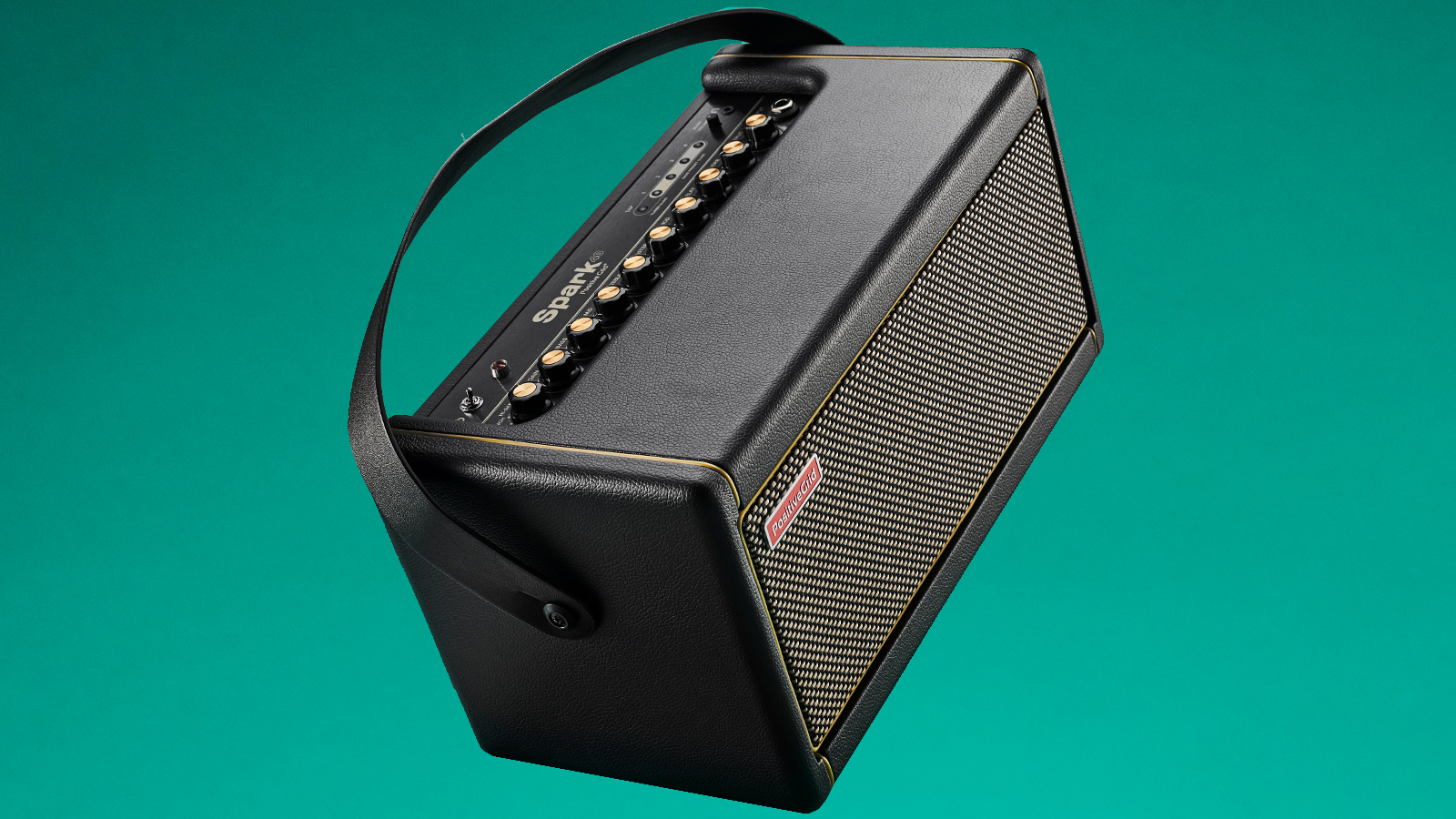
Okay, it secretly grinds my gears to discover an amp that appears to be more intelligent than I am. Sigh. Perhaps I need to go to a repairman and get “re-tubed”. That said, the Spark and its little brother, the battery-powered Spark Mini, are pretty brilliant.
In addition to being one of the best-sounding practice amps on the market, they include a companion app that allows you to program and tweak more than 10,000 sounds. If that’s not enough, the Spark app also has a feature that’ll analyze what you play and automatically create a bass and drum part that complements it, and, if you’re feeling lazy, it can also figure out the chords to your favorite songs.
Is A.I. the future? Most likely. Now, if they can only invent an amp that serves a cold beer…
A long time ago in a galaxy far, far away Brad was the editor of Guitar World from 1990 to 2015. Since his departure he has authored Eruption: Conversations with Eddie Van Halen, Light & Shade: Conversations with Jimmy Page and Play it Loud: An Epic History of the Style, Sound & Revolution of the Electric Guitar, which was the inspiration for the Play It Loud exhibition at the Metropolitan Museum of Art in New York City in 2019.

















